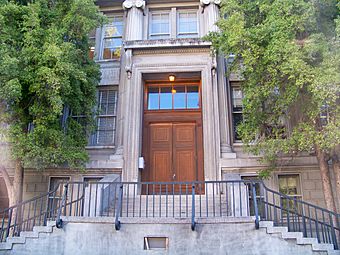Gilman Hall facts for kids
|
Room 307, Gilman Hall, University of California, Berkeley
|
|

Front entrance
|
|
| Location | University of California at Berkeley campus, Berkeley, California |
|---|---|
| Built | 1916-1917 |
| Architect | John Galen Howard |
| NRHP reference No. | 66000203 |
Quick facts for kids Significant dates |
|
| Added to NRHP | October 15, 1966 |
| Designated NHL | December 21, 1965 |
Gilman Hall is an important building at the University of California, Berkeley. It's famous because of Room 307. In this room, a scientist named Glenn T. Seaborg and his team made a huge discovery. On February 23, 1941, they found a new chemical element called plutonium.
Because of this discovery, Room 307 is now a National Historic Landmark. This means it's a special place recognized for its history. The whole building, Gilman Hall, is also a National Historic Chemical Landmark. This honor celebrates the two Nobel Prizes in Chemistry that came from research done right here.
Contents
Building History
Gilman Hall was built between 1916 and 1917. It was designed by John Galen Howard. The building was made to help the College of Chemistry grow. It provided new places for scientists and students to do research. They studied different types of chemistry, like physical, inorganic, and nuclear chemistry. The building was named after Daniel Coit Gilman. He was the president of the University of California from 1872 to 1875.
Room 307 and War Research
In 1942, the Berkeley campus became very involved in World War II. The top floor of Gilman Hall was closed off for secret work. This work was about nuclear chemistry. Some rooms on this floor had small balconies. These could be used like outdoor fume hoods to keep air safe.
The regular fume hoods in Gilman Hall didn't have fans at first. They just used a flame to create a draft. But for the important war research, electric fans were added. These fans helped to properly vent the hoods. The plutonium research in Gilman Hall was part of the Manhattan Project. This project was a secret effort to develop new technologies during the war.
In 1942, Glenn Seaborg left Berkeley to work on the Manhattan Project in Chicago. After the war, he came back to Berkeley. He then led the university's nuclear chemistry research.
Later, between 1976 and 1983, some cleanup work happened. The United States Department of Energy helped remove or cover parts of the floor and walls. These areas had tiny amounts of uranium from the old nuclear research. This cleanup made sure the building was safe.
Nobel Prize Winners
Two Nobel Prizes in Chemistry have been given for research done in Gilman Hall. A Nobel Prize is a very famous award for amazing discoveries.
- The first Nobel Prize went to William Giauque in 1949. He won for his studies on how matter behaves at extremely cold temperatures.
- The second Nobel Prize was given to Glenn Seaborg in 1951. He won for his discoveries of transuranium elements. These are elements heavier than uranium.
Four other scientists also did research here. They later received Nobel Prizes for other important work.
Gilman Hall Today
Gilman Hall has been used by the College of Chemistry for over 80 years. Today, the Department of Chemical and Biomolecular Engineering uses it. The building's old lab equipment isn't right for modern research. So, the university has updated some rooms. They have been changed into offices, classrooms, and smaller research labs.
After the cleanup work, Gilman Hall was certified as safe. It meets all current safety standards for radiation. The University of California is in charge of keeping it maintained and monitored.
Images for kids
![]() This article incorporates public domain material from websites or documents of the National Park Service.
This article incorporates public domain material from websites or documents of the National Park Service.



